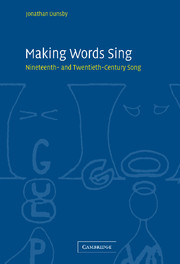Book contents
- Frontmatter
- Contents
- Acknowledgements
- Introduction
- 1 An introduction with no words, with intended words, and untheory
- 2 A love song: Brahms's ‘Von ewiger Liebe’
- 3 Boundless opulence: postscripts on Schoenberg's premonition
- 4 Interlude on peace, laws, flowers, and men flying
- 5 To Amherst via Vienna
- 6 By way of brief conclusion
- Bibliography
- Index
1 - An introduction with no words, with intended words, and untheory
Published online by Cambridge University Press: 23 November 2009
- Frontmatter
- Contents
- Acknowledgements
- Introduction
- 1 An introduction with no words, with intended words, and untheory
- 2 A love song: Brahms's ‘Von ewiger Liebe’
- 3 Boundless opulence: postscripts on Schoenberg's premonition
- 4 Interlude on peace, laws, flowers, and men flying
- 5 To Amherst via Vienna
- 6 By way of brief conclusion
- Bibliography
- Index
Summary
MUSIC WITHOUT WORDS
One of the most clearly descriptive generic titles of Western music of recent centuries is also one of the most intriguing: ‘Das Lied ohne Worte’, the Song without Words. Mendelssohn published six volumes of forty-eight such pieces in 1832–45, often charming, sometimes deeply moving, in some cases composed simply, very ‘playable’ and in ‘folk’ style, in other cases – rather less commonly – extremely skilful compositionally in ways that are easy to perceive (for example, in the A-flat ‘Duetto’, No. 18, which combines on one instrument the female and male ‘voice’, separately as well as ‘singing’ together, with full piano accompaniment). The very title ‘Song without Words’ triggers unusual questions. Why, for instance, would anyone want to write a wordless song? How do we know in the absence of words that a ‘song’ is what this kind of music is designed to be? And is music of this kind supposed to be instead of song, some kind of complement to the ‘real’ thing, or is it perhaps the best that can be done alone at the piano (assuming that the pianist lacks the ability to sing and play simultaneously to the same standard?), and is it thus a makeshift of some sort?
Julian Rushton is right, I believe, to point in his essay ‘Music and the Poetic’ to the aura of heightened expression and what will be called here a kind of ‘transvocality’ in this period, which makes the Song without Words seem a most natural genre in the wider context:
An absence of specificity is a vital part of the Romantic project which finds poetry in unmediated sound …[…]
- Type
- Chapter
- Information
- Making Words SingNineteenth- and Twentieth-Century Song, pp. 10 - 32Publisher: Cambridge University PressPrint publication year: 2004

